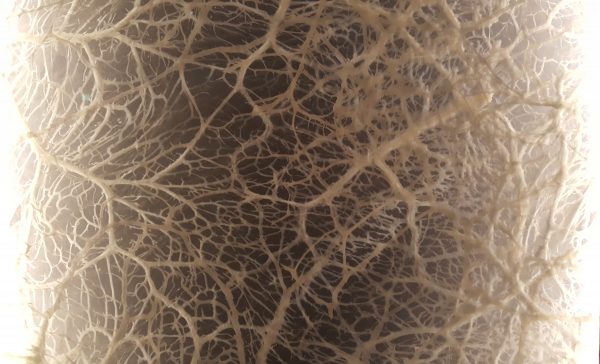A print of a cow’s rectum. some glowing sheep’s testicles, pig’s fat as lamps, a levitating cow stomach, all mark an exhibition of art made from often discarded animal parts.
Creating sculptures and installations from caul fat (the tissue that encases pig stomachs and intestines) and other animal organs, artist Elpida Hadzi-Vasileva has drawn attention to parts of the body we would sometimes rather forget.
The genesis of the art is based on actual science being carried out at UCL, to develop biodegradable microscopic spheres, which are implanted in people’s bodies to slowly release pre-loaded drugs, or to provide a scaffold for tissues to regrow.
The research focuses on nutrition, our gut and how man-made, microscopic materials can fix problems, and the art reuses those parts of the body that are being targetted by the research.
It’s a curious mix of fairly humdrum art, and some which looks like plain ordinary modern art, until you read the small white card next to it.
A series of glowing bulbs on a wall could be some modern light display with fancy blown glass, until you realising you’re admiring the result of castrated sheep – their testicles. That one looks remarkably like the human pods from the movie The Matrix doesn’t help to settle the stomach.
Talking of which, a cows stomach, dried and hung in the air wrapped in a wooden cocoon is just around the corner. A black print looking not too dissimilar to the ink prints done at school is actually of a cow’s rectum.
Less revolting to think about, a smaller collection of animal skulls clad in gold are laid out in ordered rows.
What’s interesting the display is to look at something quite beautiful, then realise its not just made from an animal, but from the parts we tend to prefer not to think about. We have a curious queasiness about seeing beneath the skin. While many can admire the glossy shine of a good liver or a heart, for these are the essence of life, we rather not think about the fats and tissues that make up the protective layers around them.
Pulling them out and turning them into art forces us to confront our squeamish side, but safely, at a distance, with flesh turned into art.
Most striking, a couple of panels of what looks like finely etched glass, is even more impressive looking finely etched glass when you look closer. It is in fact made from caul fat, the tissue that encases pig stomachs and intestines.
The exhibition, Internal Beauty is open at the Grant Museum until 28th March. Entry to the museum is free.











